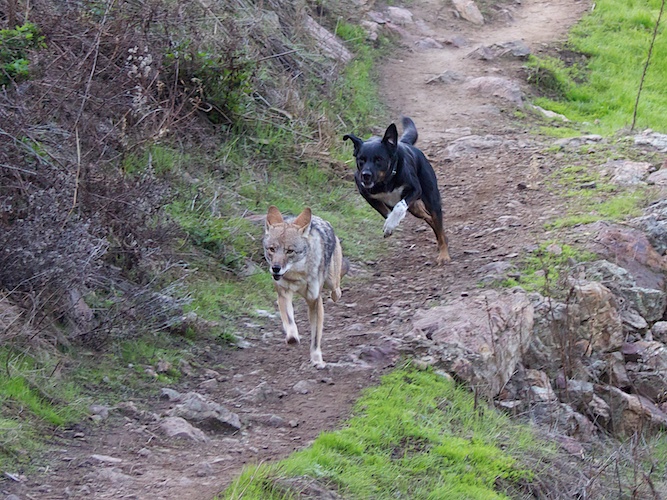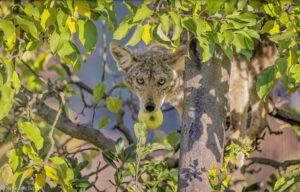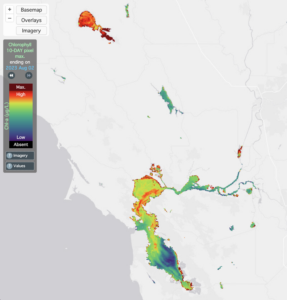When a pet goes missing, urban coyotes can quickly develop a bad rap. But many wildlife experts say it’s not the coyotes who need better management — it’s us.
Most of the time coyotes live peaceably among their human neighbors, often going unnoticed as they prefer the secrecy of the night. But when conflicts do arise, it’s often humans who set the stage by feeding coyotes, or disregarding trail closures and dog leash laws.
“The best way to manage coyote behavior is to manage human behavior,” said Damien Raffa, the education program manager of the Presidio Trust, quoting a veteran park ranger.
In this third and final Bay Nature installment on urban coyotes, we examine how people can help keep the peace with the normally reclusive Canis latrans as it expands its range into cities like San Francisco. In the second story in the series we looked at why coyotes see cities, of all places, as ideal habitat, and in the first story we uncovered how they got to San Francisco in the first place.
Loving coyotes to death
Conflict between urban coyotes and people can unfold in many ways, but most cases starts with wildlife feeding, which creates a big problem fast.
“Feeding wildlife is literally loving animals to death,” says Camilla Fox, the executive director of the Larkspur-based coyote education nonprofit, Project Coyote.
When leaving food outside for pets, cat colonies, or other wildlife, you also lure coyotes in to human areas and teach them that humans are the key to a delicious meal.
Feeding can also be the gateway to habituation, a phenomenon where a coyote loses its natural fear of people due to one too many innocuous interactions. A habituated coyote may be more bold, curious, and likely to explore new urban terrain, regardless of how many people and cars stand in its way.
“There’s more chance for something bad to happen,” said Bill Merkle, a wildlife ecologist at the Golden Gate National Recreational Area. “These animals are still wild and unpredictable.”
Habituation and wildlife feeding are also a community problem. Even if only one person feeds a coyote, pretty soon the whole neighborhood might have a regular, uninvited backyard guest who may even get a bit testy at times, or sample a pet as a meal.
“If a person gets bit, it’s likely because the coyote was habituated due to feeding,” said Stanley Gehrt, a leading urban coyote expert and associate professor at the Ohio State University.
But habituation goes both ways and sometimes it’s hard to say who habituated first, the coyote or the human. People are quick to forget that a city coyote is still a wild coyote, and therefore definitely not a playmate for their dog or a furry friend in need of some TLC.
The dog conundrum
While conflicts were once mostly limited to missing cats, these days scuffles with dogs — off-leash in parks and in backyards — are the most common problem.
In San Francisco, where the luxury of a backyard is few and far between, most dog-coyote conflicts occur in Glen Canyon Park and Golden Gate Park, places where dog walkers frequent and often disobey on-leash laws.
“Dog owners violate leash laws, which results in playful or curious dogs approaching coyotes,” said Lt. Lee-Ellis Brown of San Francisco Animal Care and Control. “We wouldn’t have this kind of dog-coyote problem if owners kept their dogs on leash in designated areas.”.
The coyote usually chases away the dog, and then a report is filed with Animal Care and Control, although sometimes it’s the dog that gains the upper hand.
Usually the trouble is the worst during pupping season (April, May and June), when coyotes are unamused by dogs running around their dens.
“We are trying to promote the consciousness that free-roaming pets are possible participants in the food web of the park. It’s painful to lose a pet, and completely avoidable with a mindful effort,” said Raffa of the Presidio Trust.
Getting proactive
After years of experience dealing with coyote conflicts, San Francisco officials are now proactive in their efforts. The city has started closing off trails near den sites and enforcing on-leash dog laws during the height of coyote pupping season. And it’s broadcasting its message to residents through community meetings, fliers and public service announcements to teach people to be cognizant of coyotes and their needs. It’s a policy that Fox said should serve as a model for other cities which should be “managing” humans to keep the peace with coyotes.
That comes down to correcting misperceptions about coyotes, changing the way people and their pets behave around them, and shaping media coverage of sightings and incidents.
“The media feeds into the fear mongering with sensationalist headlines. We don’t hear about all of the times we are coexisting with these animals. People end up being terrified,” says Fox.
Living peacefully among our canine neighbors requires some work on our part. To learn more about how to coexist with urban coyotes and recognize warning signs, visit The Cook County Coyote Project and Project Coyote.
[slideshow]
Courtney Quirin is a Bay Nature editorial intern.





